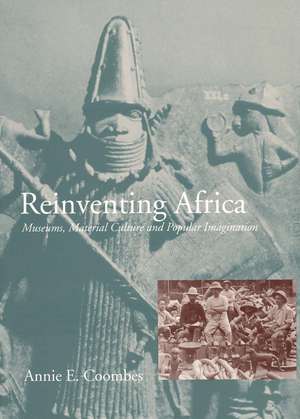Reinventing Africa: Museums, Material Culture and Popular Imagination in Late Victorian and Edwardian England
Autor Annie E. Coombesen Limba Engleză Paperback – 20 oct 1997
Between 1890 and 1918, British colonial expansion in Africa led to the removal of many African artifacts that were subsequently brought to Britain and displayed. Annie Coombes argues that this activity had profound repercussions for the construction of a national identity within Britain itself—the effects of which are still with us today.
Through a series of detailed case studies, Coombes analyzes the popular and scientific knowledge of Africa which shaped a diverse public's perception of that continent: the looting and display of the Benin "bronzes" from Nigeria; ethnographic museums; the mass spectacle of large-scale international and missionary exhibitions and colonial exhibitions such as the "Stanley and African" of 1890; together with the critical reaction to such events in British national newspapers, the radical and humanitarian press and the West African press.
Coombes argues that although endlessly reiterated racial stereotypes were disseminated through popular images of all things "African," this was no simple reproduction of imperial ideology. There were a number of different and sometimes conflicting representations of Africa and of what it was to be African—representations that varied according to political, institutional, and disciplinary pressures. The professionalization of anthropology over this period played a crucial role in the popularization of contradictory ideas about African culture to a mass public.
Pioneering in its research, this book offers valuable insights for art and design historians, historians of imperialism and anthropology, anthropologists, and museologists.
Through a series of detailed case studies, Coombes analyzes the popular and scientific knowledge of Africa which shaped a diverse public's perception of that continent: the looting and display of the Benin "bronzes" from Nigeria; ethnographic museums; the mass spectacle of large-scale international and missionary exhibitions and colonial exhibitions such as the "Stanley and African" of 1890; together with the critical reaction to such events in British national newspapers, the radical and humanitarian press and the West African press.
Coombes argues that although endlessly reiterated racial stereotypes were disseminated through popular images of all things "African," this was no simple reproduction of imperial ideology. There were a number of different and sometimes conflicting representations of Africa and of what it was to be African—representations that varied according to political, institutional, and disciplinary pressures. The professionalization of anthropology over this period played a crucial role in the popularization of contradictory ideas about African culture to a mass public.
Pioneering in its research, this book offers valuable insights for art and design historians, historians of imperialism and anthropology, anthropologists, and museologists.
Preț: 369.33 lei
Nou
Puncte Express: 554
Preț estimativ în valută:
70.68€ • 76.75$ • 59.37£
70.68€ • 76.75$ • 59.37£
Carte tipărită la comandă
Livrare economică 22 aprilie-06 mai
Preluare comenzi: 021 569.72.76
Specificații
ISBN-13: 9780300068900
ISBN-10: 0300068905
Pagini: 292
Ilustrații: 112 b-w illus.
Dimensiuni: 203 x 254 x 16 mm
Greutate: 0.58 kg
Ediția:Revised
Editura: Yale University Press
Colecția Yale University Press
ISBN-10: 0300068905
Pagini: 292
Ilustrații: 112 b-w illus.
Dimensiuni: 203 x 254 x 16 mm
Greutate: 0.58 kg
Ediția:Revised
Editura: Yale University Press
Colecția Yale University Press
